September 21 is Moroccan Jewish Day on campus. This annual event is organized by the Mimouna Club, a student club devoted to raising awareness of Morocco’s Jewish heritage. The main event this year, co-sponsored by KIVUNIM, is an international seminar on the response of Sultan Muhammad bin Yusuf (Muhammad V’s official title at the time) to the anti-Semitic pressures and genocidal policies of the Vichy regime during World War II.
 A number of Moroccan and American historians are presenting at the seminar, one of the panels of which I will be moderating. You can download a list (pdf file) of seminar participants here. (Postscript: this event was written up in both the New York Times and Haaretz on Saturday 23rd of September, and a follow-up event was held during the Kristallnacht Program at the Abraham Joshua Heschel School in New York City on Wednesday 9th of November)
A number of Moroccan and American historians are presenting at the seminar, one of the panels of which I will be moderating. You can download a list (pdf file) of seminar participants here. (Postscript: this event was written up in both the New York Times and Haaretz on Saturday 23rd of September, and a follow-up event was held during the Kristallnacht Program at the Abraham Joshua Heschel School in New York City on Wednesday 9th of November)
In keeping with the description and mapping of shrines which characterizes this blog, AUI’s Moroccan Jewish Day is a good opportunity to post a notice about one of Morocco’s major Jewish shrines, that of Rabbi Amram ben Diwane in Azjèn, near Ouezzane.
The veneration of saints, often at shrines consisting of cemeteries and mausolea, is a trait which Morocco’s Muslims and Jews share. Regardless of whether they are dedicated to a Muslim or a Jewish saint, many of Morocco’s shrines have attracted members of both faiths alike.
The shrine of Rabbi Amram ben Diwane is one of Morocco’s major Jewish shrines. It is located in the village of Azjèn (sometimes spelled Asjèn), about 6 kilometers north-west of the Sufi town of Ouezzane (or Wazzân, subject of my next post). A paved road leads from Ouezzane directly to the shrine. Download this Google Earth (kmz) file for the shrine’s exact location.
The Ouezzane area, in the foothills of the Jbala Mountains, is a fine example of the type of rolling pied-de-mont landscape (called dîr in Moroccan Arabic) Fernand Braudel claimed lay at the heart of Mediterranean civilization. It exhibits a familiar mix of dry cereal farming, irrigated vegetable plots and the ubiquitous olive groves—the Ouezzane area is famous for its olive oil.
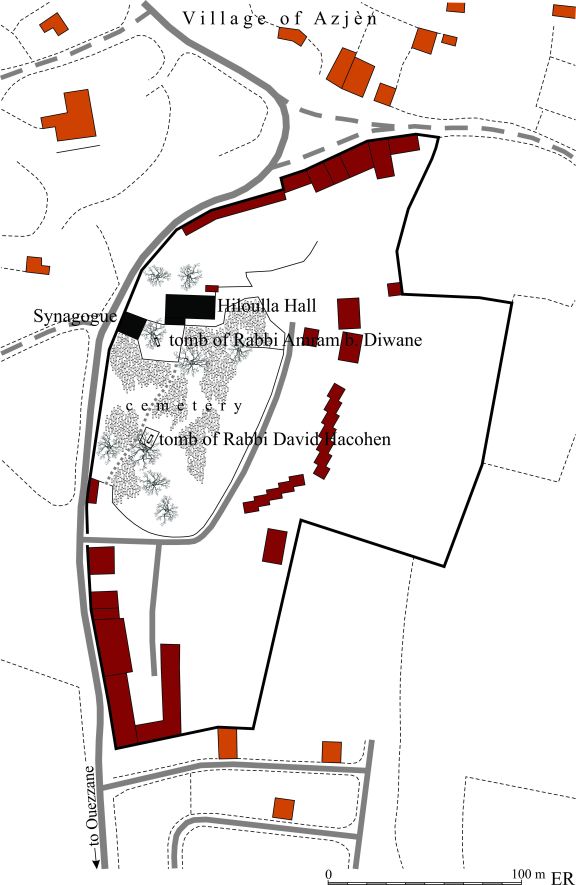
The shrine of Rabbi Amram ben Diwane is centered on a cemetery, where the tzadiks are buried, a synagogue and a large festival hall. Beyond these are hostels and camp grounds for pilgrims.
Rabbi Amram ben Diwane (d. 1781) arrived in Morocco in 1743 from Ottoman Palestine. He was sent to Morocco by the rabbis of Hebron to collect funds for their yeshivot. The rabbis of Fez and Sefrou embraced him because of his erudition. He toured Morocco for years, collecting funds, teaching and disseminating wisdom. Recognized as a tzadik (both erudite and pious), his reputation survived his death.
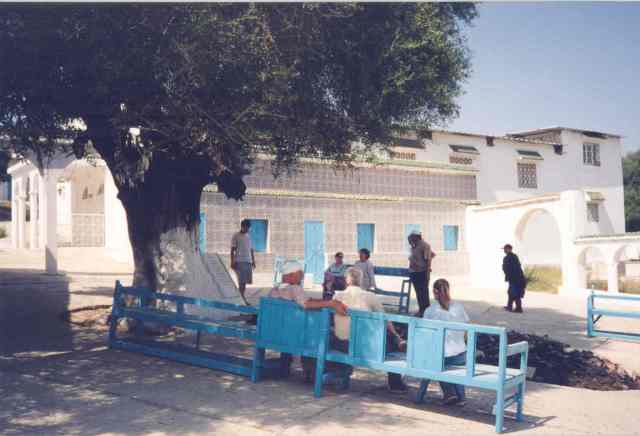
Visitors to the shrine gather around the tomb of Rabbi Amram. The large building in the background is the hiloulla hall. (ph. Eric Ross)
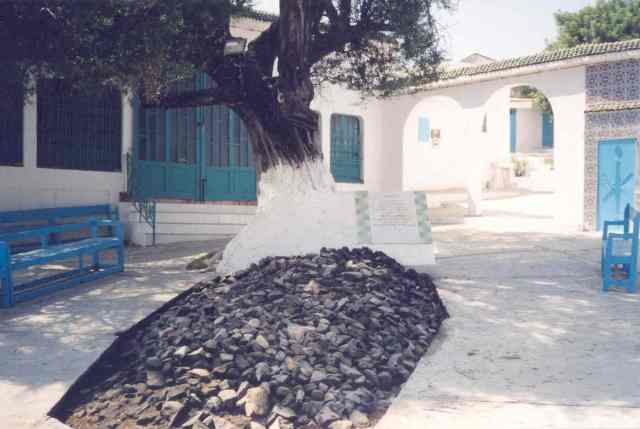
The tomb of Rabbi Amram consists of a bed of stones at the base of a large olive tree. Visitors place lit candles on the stones. The glass doors just behind the tree lead to the synagogue. (ph. Eric Ross)
The shrine of Rabbi Amram ben Diwane consists of a cemetery graced by venerable olive trees. Both his tomb and that of the other tzadik buried there, Rabbi David Hacohen, are actually marked by olive trees. The graves consist of piles of stones at the base of these trees. Those who visit the shrine will place lit candles on the stones. When I visited the tomb of Rabbi Amram, on a Sunday afternoon in June 2002, the hot stones were still smoldering with slowly burning wax from the candles that had been burnt there on the Sabbath.

Within the enclosure, a round bed of stones and a young olive tree mark the grave of Rabbi David Hacohen (ph. Eric Ross)
There is a synagogue next to the tomb of Rabbi Amram. Next to these again is the “hiloulla hall” (I don’t think this is what it is called. I am the one who is calling it this), where pilgrims gather to feast, sing and dance during the annual hiloulla, a North African term which designates a pilgrimage to a Jewish shrine.
Apart from the cemetery with its synagogue and hiloulla hall, the shrine has a number of hostels and camp grounds to accommodate the pilgrims, many of whom travel from as far away as France, Canada and Israel on an annual or bi-annual basis.
The satellite image below shows the shrine on October 1st 2007.

The cemetery-shrine of Rabbi Amram ben Diwane as seen from space on 1 Oct. 2007 (source: Google Earth)
These YouTube video links (http://www.youtube.com/watch?v=H03ZFgWaQfM, http://www.youtube.com/watch?v=jXgCn8-P3dE&feature=related) can give you an idea of what the hiloulla of Rabbi Amram has been like in recent years.
Another link related to the shrine of Rabbi Amram: http://solyanidjar.superforum.fr/t276-rebbi-amran-ben-diwan

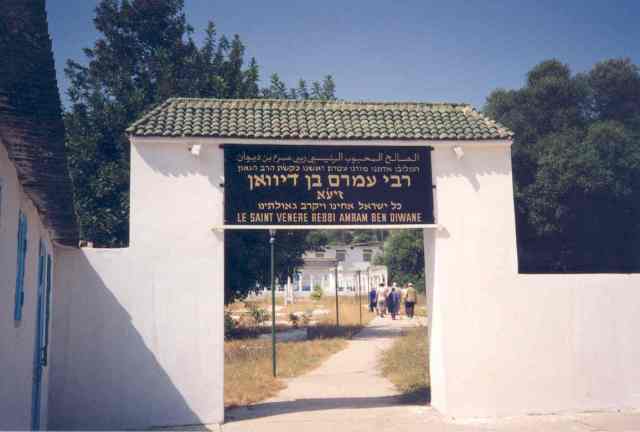
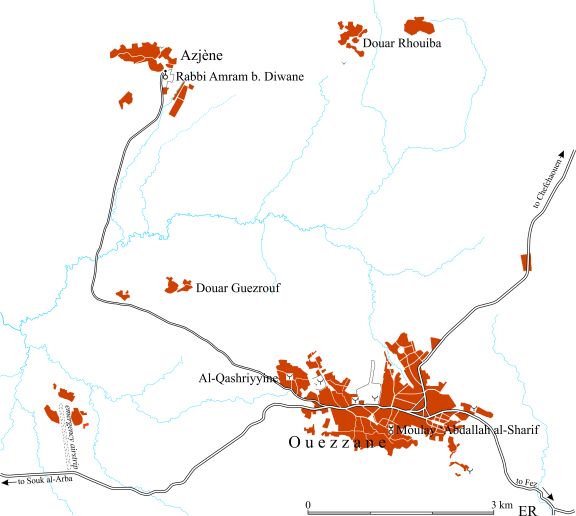
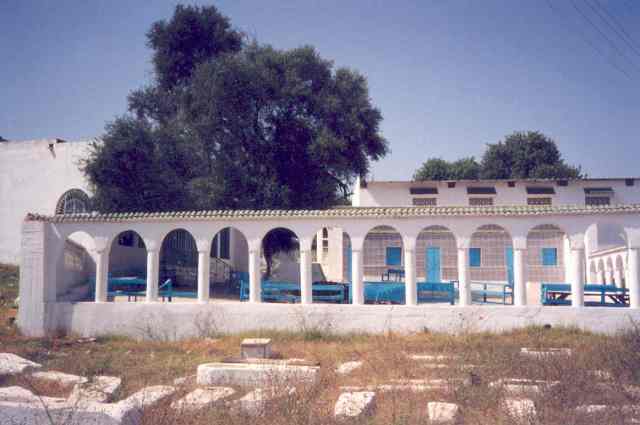
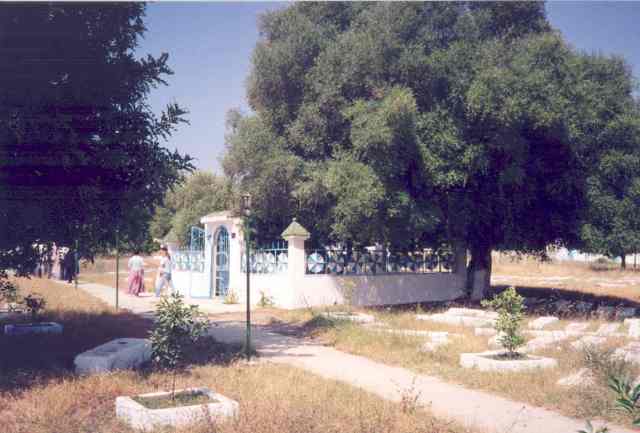

Greetings Dr. Ross,
I was very interested in the “shrine” information you posted. I find the interfaith and use of candles in Catholic, Jewish and Muslim tradition very interesting. A symbolic way to “give light, pay respect, and meditate.” Thanks for the beautiful photos! Dr. Minnie Almader, Counselor
Pingback: Shrines of Ouezzane | Eric Ross, academic
shalom! I would like to know how much does itt cost to vizit the tomb. Thank you.
Shalom. There is no charge for visiting the tomb. If you visit it during the pilgrimage (late August) you will be in the company of many other devotees. Other times of the year the shrine is locked. You can ask for the caretaker in the village of Azjen. He has the keys and will gladly show you around.
Best Regards,
Eric